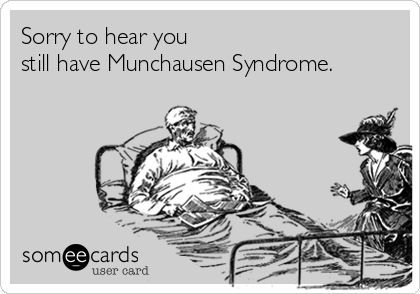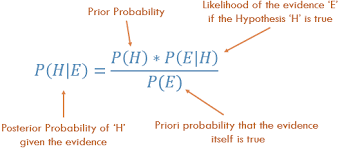Note: This is a piece I wrote for my fourth-year course, “Voodoo Science”, at Macquarie University back in 2006, so the references are rather dated. Thanks to Professor Dick Stevenson for this inspiring course!
The strange Case of Roy Meadow and Munchausen Syndrome by Proxy
Background
The unusual disorder of Munchausen Syndrome by Proxy was first reported by Roy Meadow (Meadow, 1977) . In Munchausen Syndrome itself, now referred to in DSM-IV-TR (2000) as Factitious Disorder, an individual deliberately fakes or induces symptoms of illness solely in order to assume the sick role, rather than for any material gain or to avoid work. The symptoms can be mainly physical, mainly psychological, or a combination of both. In the case of Munchausen Syndrome by Proxy or Factitious Disorder by Proxy (at present a provisional diagnosis in DSM-IV-TR), the parent (usually the mother) induces symptoms of illness in a person under her care (usually a young child), in order to assume the sick role by proxy, rather than for any other gain.

Meadow’s original (1977) paper describes two cases. In the first, a 6-year-old female was admitted because of recurrent suspected urinary infections, with no apparent cause. After repeated investigatory procedures, the mother was discovered doctoring the urine samples with her own urine. In the second case, a very young male baby was admitted with abnormally high blood sodium levels but no other apparent abnormality. The baby’s condition stabilised when the mother was not present, but he eventually collapsed and died; the mother subsequently attempted suicide, but there does not appear to be any conclusive proof of sodium poisoning in this case.
Meadow proposed that the common factor in both cases was the mothers’ motivation to use the child’s illness to gain attention for themselves, and termed the condition “Munchausen Syndrome by Proxy”. Many more cases of MSBP were reported in the literature following his original paper (for a review, see Sheridan, 2003), although surprisingly few offer independent corroboration of the faking of symptoms, and there is a notable absence of studies using control groups.
Roy Meadow and his lucrative career as an expert witness.
Meadow went on to become a well-respected authority on child abuse and was knighted in 1998 for his services to child welfare (Dyer, 2005). He is now retired from paediatric practice but has, until recently, been frequently engaged as an expert witnes in court cases where parents are suspected of covertly poisoning or harming their children in order to gain medical attention. But his evidence in a particular recent case, that of Sally Smith, caused an unexpected furore. Smith was accused of murdering her two infant children. The pathological evidence was somewhat confusing and contradictory, and Meadow’s evidence contained a startling statistic that could have moved the jury to convict: he testified that the chance of two infants within the same family dying of natural causes was vanishingly small, around 1 in 72,000,000. This was calculated by taking the probability of a single infant within an affluent, non-smoking family dying of SIDS, and squaring it. Meadow testified that this was so unlikely as to happen by chance only once in a hundred years. This was taken to represent the probability of Clark’s innocence: it was extremely unlikely that the infants had died naturally, therefore she must have murdered them.

The glaring errors in this statement moved the Royal Statistical Society to issue a press release on the subject (Royal Statistical Society, 2001). The first is that the squaring of the probability of a single death is only appropriate if the two events are statistically independent; in fact, several epidemiological studies had already shown that this was far from being the case, and that in fact a sibling of a child who has died of SIDS is up to ten times more likely to suffer the same fate (Hill, 2004); furthermore, Meadow must have known this as he had reviewed two recent papers on the subject (Fitness to Practice Panel: Sir Roy Meadow, 2005).
The Prosecutor’s Fallacy
The most glaring flaw, however, is a common logical error known as the Prosecutor’s Fallacy. Hill (2004) points out that the death of two infants within a family from any cause is extremely unusual and, in itself, takes up most of the improbability: the appropriate analysis is to calculate the relative probability that these deaths were natural rather than unnatural. Although double SIDS is extremely unusual, double infant murder is even more unusual, and although SIDS is less common in Clark’s middle-class demographic, so is infant murder, so the relative probabilities remain similar. Hill’s calculation is that the relative probability that the babies were murdered, rather than dying of SIDS, would be somewhere between 1:4.5 and 1:9; thus it is more likely, on the balance of probabilities, that the babies’ deaths were natural. This is supported by a detailed follow-up study of all families in Britain in which a child had died of unexplained causes, the Care of Next Infant programme (CONI) (Carpenter et al., 2005); it was found that subsequent deaths of siblings were more likely than not to be natural.

This flatly contradicts “Meadow’s Law” that “one cot death is a tragedy, two cot deaths is suspicious, and, until the contrary is proved, three is murder” (Hill, 2004, p. 320), which has frequently been cited in court cases. It seems this so-called “Law” may be based on a faulty understanding of probability, and thus much of Meadow’s “expert” testimony might be considered questionable: a point which figured prominently in the General Medical Council hearing in which Meadow was found guilty of serious professional misconduct and struck off the medical register (Dyer, 2005). This decision was reversed on appeal in February 2006 (Dyer, 2006), on the grounds that immunity should be granted to expert witnesses. But doubts must arise about the conclusions Meadow has drawn in published papers on MSBP, if his understanding of statistics is so shaky. For instance, in 1999 he published a paper suggesting that many cases of SIDS might, in fact be undiagnosed MSBP (Meadow, 1999): this was based on an uncontrolled case series of 81 cases over 18 years, many consisting of those in which he had been involved and often testified as an expert witness; thus circular reasoning is involved (Davis, Barson, & Spencer, 1999). Meadow proudly states that the reason many families with two or more dead infants feature in the study is that “the courts were impressed by evidence that it was highly improbable for two or more children to die in infancy of undiagnosable natural causes” (Meadow, 1999, p. 11) – the Prosecutor’s Fallacy again!
Is MSBP a useful diagnosis at all?
Sally Clark was eventually freed on her second appeal (Dyer, 2003), where it was found that vital pathological evidence had been withheld at the trial. But it is likely that the jury had been unduly swayed by Meadow’s misleading statistical evidence. Several subsequent court decisions were affected, and some cases involving Meadow’s testimony are under review (Dyer, 2004).
A broader point highlighted by the Clark trial was the validity of the label of MSBP and whether it is a useful diagnosis (Mart, 1999, 2004; Morley, 1995; Pankratz, 2006). Although an early article by Meadow himself (1995) cautions against over-diagnosis, it is evident from a cursory examination of the literature that many of the case reports do not, in fact, fit the classical definition of MSBP. Southall et al. (1997) report 33 cases where the parental abuse was captured on hidden video cameras: one of the few situations in which MSBP abuse has actually been proven to occur. However, the ethics of covert video surveillance has been hotly debated (Evans, 1995; Robinson, LeGraw, & Grodin, 2001); furthermore, on closer reading, most of the cases closely resemble ordinary physical abuse than MSBP. There are no reported observational criteria for the video records, and the interpretation of some of the evidence was later disputed (Sherr, 2005). More worryingly, in Sheridan’s (2003) review of 451 reported cases of MSBP, less than a third (144) contained any evidence other than the diagnosis: of these, 60 were video evidence, 50 were at least partial confessions, and in 54 cases the child’s symptoms cleared up when removed from the parent. But symptoms can resolve simply due to the passage of time, and confessions can be forced from guilt-stricken parents under great stress; much of this “evidence”, then, may be questionable (Randerson, 2003).
Even its most enthusiastic proponents concede that genuine MSBP is extremely rare – less than 1% of parents of chronically ill children are even suspected (Mart, 1999). Problematically, suggested “warning signs” are quite general and contradictory: the mother may be oddly unconcerned with her child, or she may be over-involved; she may be agitated or too calm; she may be seemingly helpful and knowledgeable, or she may be antagonistic and over-involved with the media (Schreier, 2002). Even the provisional DSM-IV diagnosis rests on the parent’s “motivation to assume the sick role by proxy” (DSM-IV-TR, p. 783). This is, necessarily, a subjective judgment by the medical practitioner, and it could be argued that his or her own motivations could be suspect: for instance, costly malpractice suits can be avoided if the mother is considered to blame for the child’s mysterious illness (Sherr, 2005). In addition, many of the warning signs could well be shared by parents of chronically ill children who are not suspected of MSBP: no study has ever contained a control group of these parents. Thus, it is not known whether the diagnostic criteria have any reliability or validity.
The base-rate problem and conclusion
A further problem, even if the diagnosis of MSBP were 100% reliable, is the fact that it is acknowledged to be extremely unusual: thus, the base-rate is very low, and even a 5% false-positive rate would produce 4 misdiagnosed cases for every correctly diagnosed case (Mart, 1999); this is an unacceptable rate if the results of a diagnosis are (as is frequently the case) that, at the least, children are removed from their parents, or at the most, criminal proceedings are instituted at great expense. In fact, although figures are hard to come by because of the confidential nature of legal proceedings, it seems that misdiagnosis may be occurring more often than not, and with profound and devastating consequences for families (Pankratz, 2006). Although Meadow’s motives for forming the concept of MSBP may have been to protect the lives of young children, he and several others seem to have been drawn into “pathological science” through a combination of common errors of thought. Only confirmatory evidence is sought; there is over-reliance on anecdote and case history; the Prosecutor’s Fallacy and the base-rate problem are ignored. If this type of abuse does occur (and there is some evidence that it does, although very rarely), it should be simply labelled as child abuse and treated on evidence, which should not include diagnosis of any hypothetical parental pathology. The danger of damage to innocent families is too great.
References
American Psychiatric Association (2000). Diagnostic and Statistical Manual of Mental Disorders - Text Revision (Fourth ed.). Washington, DC: American Psychiatric Association.
Carpenter, R. G., Waite, A., Coombs, R. C., Daman-Willems, C., McKenzie, A., Huber, J., et al. (2005). Repeat sudden unexpected and unexplained infant deaths: natural or unnatural? The Lancet, 365(9453), 29-35.
Davis, J. A., Barson, A. J., & Spencer, N. J. (1999). Unnatural sudden infant death. Archives of Disease in Childhood, 81(1), 96.
Dyer, C. (2003). Sally Clark freed after appeal court quashes her convictions. BMJ, 326(7384), 304.
Dyer, C. (2004). Eight cases of parents convicted of killing their children are referred to commission. BMJ, 329(7471), 878.
Dyer, C. (2005). Professor Roy Meadow struck off. BMJ, 331(7510), 177.
Dyer, C. (2006). Meadow should never have been brought before the GMC. BMJ, 332(7539), 439-.
Evans, D. (1995). The investigation of life-threatening child abuse and Munchausen Syndrome by Proxy. Journal of Medical Ethics, 21(1), 9-13.
Fitness to Practice Panel: Sir Roy Meadow, General Medical Council (2005). Downloaded on 22/10/2006 from http://www.gmcpressoffice.org.uk/apps/news/latest/detail.php?key=180
Hill, R. (2004). Mulitple sudden infant deaths - conicidence or beyond coincidence? Paediatric and Perinatal Epidemiology, 18, 320-326.
Mart, E. (1999). Problems with the diagnosis of factitious disorder by proxy in forensic settings. American Journal of Forensic Psychology, 17(1), 69-82.
Mart, E. (2004). Factitious disorder by proxy: a call for the abandonment of an outmoded diagnosis. The Journal of Psychiatry & Law, 32, 297-314.
Meadow, R. (1977). Munchausen Syndrome by Proxy: the hinterland of child abuse. The Lancet, 2(8033), 343-345.
Meadow, R. (1995). What is, and what is not, “Munchausen syndrome by proxy”? Archives of Diease in Childhood, 72(6), 534-538.
Meadow, R. (1999). Unnatural sudden infant death. Archives of Diease in Childhood, 80(1), 7-14.
Morley, C. J. (1995). Practical concerns about the diagnosis of Munchausen syndrome by proxy. Archives of Diease in Childhood, 72(6), 528-529.
Pankratz, L. (2006). Persistent problems with the Munchausen syndrome by proxy label. Journal of the American Academy of Psychiatry and the Law, 34(1), 90-95.
Randerson, J. (2003). Betrayal of innocence: parents who deliberately make their children sick to gain attention are clearly child abusers. But how often are doctors getting it wrong? New Scientist, 179(2413), 40-43.
Robinson, W. M., LeGraw, J. M., & Grodin, M. A. (2001). Case vignette: video surveillance to detect Munchausen Syndrom by Proxy. Ethics & Behavior, 11(2), 205-215.
Royal Statistical Society (2001). Royal Statistical Society concerned by issues raised in Sally Clark Case. Downloaded on 22/10/2006 from http://www.rss.org.uk/main.asp?page=1234
Schreier, H. (2002). Munchausen by Proxy defined. Pediatrics, 110, 985-988.
Sheridan, M. S. (2003). The deceit continues: an updated literature review of Munchausen Syndrome by Proxy. Child Abuse & Neglect, 27, 431-451.
Sherr, V. T. (2005). Munchausen’s syndrome by proxy and Lyme disease: Medical misogyny or diagnostic mystery? Medical Hypotheses, 65(3), 440-447.
Southall, D. P., Plunkett, M. C. B., Banks, M. W., Falkov, A. F., & Samuels, M. P. (1997). Covert video recordings of life-threatening child abuse: lessons for child protection. Pediatrics, 100(5), 735-760.
